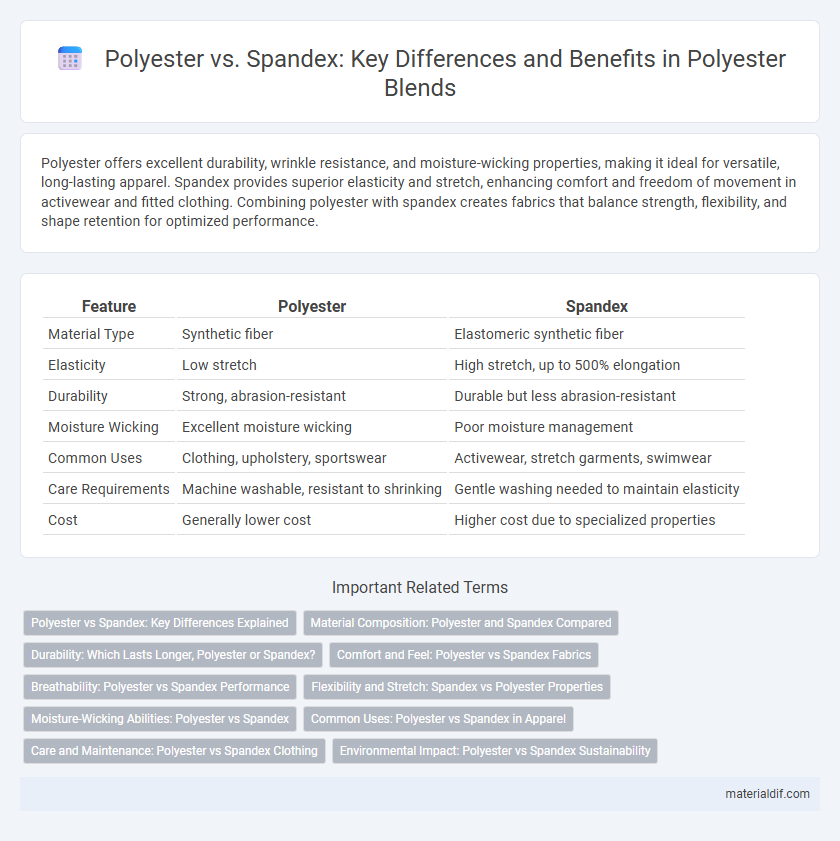Polyester offers excellent durability, wrinkle resistance, and moisture-wicking properties, making it ideal for versatile, long-lasting apparel. Spandex provides superior elasticity and stretch, enhancing comfort and freedom of movement in activewear and fitted clothing. Combining polyester with spandex creates fabrics that balance strength, flexibility, and shape retention for optimized performance.
Table of Comparison
| Feature | Polyester | Spandex |
|---|---|---|
| Material Type | Synthetic fiber | Elastomeric synthetic fiber |
| Elasticity | Low stretch | High stretch, up to 500% elongation |
| Durability | Strong, abrasion-resistant | Durable but less abrasion-resistant |
| Moisture Wicking | Excellent moisture wicking | Poor moisture management |
| Common Uses | Clothing, upholstery, sportswear | Activewear, stretch garments, swimwear |
| Care Requirements | Machine washable, resistant to shrinking | Gentle washing needed to maintain elasticity |
| Cost | Generally lower cost | Higher cost due to specialized properties |
Polyester vs Spandex: Key Differences Explained
Polyester is a durable, wrinkle-resistant synthetic fiber known for its moisture-wicking properties, whereas spandex is highly elastic, offering exceptional stretch and recovery ideal for activewear and form-fitting garments. Polyester maintains shape and resists shrinking, while spandex provides flexibility but can lose elasticity over time. Combining polyester with spandex enhances fabric performance by blending durability with stretchability, commonly used in sportswear and athleisure clothing.
Material Composition: Polyester and Spandex Compared
Polyester is a synthetic fiber made from petroleum-based polymers, known for its durability, wrinkle resistance, and moisture-wicking properties. Spandex, composed of polyurethane, offers exceptional elasticity and stretch, making it ideal for form-fitting garments and activewear. While polyester provides strength and resilience, spandex enhances flexibility and comfort through its superior stretch and recovery characteristics.
Durability: Which Lasts Longer, Polyester or Spandex?
Polyester exhibits superior durability compared to spandex due to its resistance to abrasion, stretching, and environmental factors like UV rays and moisture. Spandex, while highly elastic, tends to degrade faster with repeated stretching and exposure to heat or chlorine. Polyester-based fabrics maintain structural integrity longer, making them a preferable choice for long-lasting apparel and textiles.
Comfort and Feel: Polyester vs Spandex Fabrics
Polyester offers a smooth and slightly stiff texture that is breathable and moisture-wicking, making it ideal for athletic wear and outer layers. Spandex, known for its exceptional elasticity, provides a soft, stretchy, and form-fitting feel, enhancing comfort during movement and maintaining shape retention. The combination of polyester's durability and spandex's flexibility often results in garments that balance comfort with performance.
Breathability: Polyester vs Spandex Performance
Polyester is less breathable than spandex due to its dense fiber structure, leading to reduced airflow and moisture-wicking capabilities. Spandex fibers offer superior stretch and ventilation, enhancing breathability in activewear and athletic garments. For optimal comfort in high-intensity activities, fabrics blending polyester with spandex balance durability with improved moisture management.
Flexibility and Stretch: Spandex vs Polyester Properties
Spandex offers superior flexibility and stretch due to its exceptional elasticity, enabling it to stretch up to 500% without losing shape, whereas polyester has limited stretch and tends to retain a more rigid form. Polyester provides durability and moisture-wicking properties but lacks the ability to recover from extensive stretching as effectively as spandex. Combining polyester with spandex fabric blends marries the strength and moisture resistance of polyester with the elasticity and comfort of spandex, making it ideal for activewear and performance garments.
Moisture-Wicking Abilities: Polyester vs Spandex
Polyester exhibits superior moisture-wicking abilities compared to spandex, efficiently drawing sweat away from the skin to the fabric's surface for rapid evaporation. Its synthetic fibers are engineered to maintain breathability and dryness during intense physical activities, whereas spandex primarily offers stretch and flexibility but lacks significant moisture management properties. Consequently, polyester is preferred in activewear designed for high-performance moisture control, while spandex is often blended in smaller percentages to enhance fit and movement.
Common Uses: Polyester vs Spandex in Apparel
Polyester is widely used in apparel for its durability, wrinkle resistance, and moisture-wicking properties, making it ideal for outerwear, sportswear, and everyday clothing. Spandex, known for its exceptional stretch and recovery, is primarily utilized in activewear, swimwear, and form-fitting garments where flexibility and comfort are essential. Blending polyester with spandex enhances fabric performance by combining strength, stretch, and breathability, common in leggings, athletic shirts, and compression wear.
Care and Maintenance: Polyester vs Spandex Clothing
Polyester clothing offers high durability and resists shrinking, wrinkling, and stretching, making it easier to care for with regular machine washing and low heat drying. Spandex garments require more delicate maintenance, including hand washing or gentle machine cycles with cold water to preserve elasticity and prevent damage. Avoid high temperatures and bleach for spandex to maintain fabric integrity, while polyester tolerates more robust cleaning methods without losing shape or color.
Environmental Impact: Polyester vs Spandex Sustainability
Polyester production relies heavily on petroleum, contributing to high greenhouse gas emissions and non-biodegradability, raising significant environmental concerns. Spandex manufacturing also involves synthetic chemicals but typically has a smaller carbon footprint due to lower material volumes in garments. Both fibers pose sustainability challenges, though polyester's prevalence in fast fashion amplifies its ecological impact compared to spandex.
Polyester vs Spandex Infographic

 materialdif.com
materialdif.com